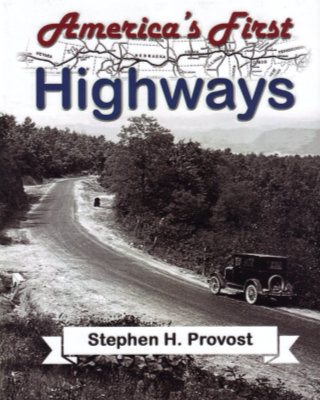 I knew nothing of this book or its author until just before it was reviewed in the Jefferson Highway Association newsletter, The Declaration. The only reason I learned of it that early was because the reviewer, Wayne Shannon, is a friend whom I happened to chat with by phone while he was putting his review together. He was quite positive in talking about the book but, like me, unfamiliar with the name Stephen H. Provost.
I knew nothing of this book or its author until just before it was reviewed in the Jefferson Highway Association newsletter, The Declaration. The only reason I learned of it that early was because the reviewer, Wayne Shannon, is a friend whom I happened to chat with by phone while he was putting his review together. He was quite positive in talking about the book but, like me, unfamiliar with the name Stephen H. Provost.
Wayne’s positive comments prompted me to order America’s First Highways before I had seen his actual review. In the process of ordering, I discovered that Provost is an experienced journalist and editor with more than three dozen books to his credit. The overwhelming majority of those books are fiction which helps explain the lack of name recognition by at least some road buffs. I believe this is Provost’s fourth road-related book. He is a Californian so there’s not much surprise in his first two road books being Highway 99 and Highway 101. The cover of Highway 99 did look familiar to me when I saw it online but I could not recall where I had seen it or in what context nor did I remember the author. That simply reinforces something that everyone already knows about me. I’m not too bad with faces but horrible at remembering names.
Provost’s third road-related book, Yesterday’s Highways, appeared just a few months ahead of the subject of this review. The timing of their publication suggests that they are to be viewed as a pair and that idea is cemented by this book being identified internally as “Volume II America’s Historic Highways”. It is my understanding that they split history in the reverse sequence of their publication with America’s First Highways culminating in the mid-1920s when the United States Numbered Highway System came into being, and Yesterday’s Highways picking up the story, with some overlap, there. Please note that I’ve yet to actually see one of these books so take that description with a grain of salt.
The one that I have seen is logically divided into two parts. They are described by a phrase on the first page that is almost, but not quite, a subtitle: “Auto Trails and the Quest for Good Roads”. Their actual titles are “Trail Blazers” and “Trail Builders”.
“Part 1: Trail Blazers”, a.k.a., “the Quest for Good Roads”, focuses on the late 19th and early 20th century when devices capable of utilizing long-distance roads were starting to appear with essentially no long-distance roads in existence. Bicycles were the first such devices to arrive with automobiles close behind. People had, of course, been traveling long distances for quite some time. Some traveling was by foot or in wagons pulled by horses and oxen where smooth roads were appreciated but not absolutely required. Other traveling was by train which demanded and constructed its own specialized form of smooth roads. Bicycles and automobiles offered more flexibility than trains and more speed than walking but required supporting infrastructure. The quest for good roads was somewhat formally recognized in The Good Roads Movement originated by cyclists but soon supported by motorists as well.
Provost writes about individuals and organizations, including manufacturers, working for good roads, then uses a goodly portion of Part 1 to describe organized events that drew attention to the need for improvements in roads and demonstrated improvements in the machines that traveled on them. There is a chapter on “Road Tests” such as the Glidden Tours and another on “Great Races to Strange Places” such as the 1908 New York to Paris race.
“Part 2: Trail Builders”, forms the bulk of the book. One of the builders is, of course, Carl Fisher so there is significant coverage of the Lincoln and Dixie Highways he promoted. Under the heading “Land of Confusion”, Provost provides coverage of the Lee Highway, Jefferson Davis Highway, Jackson Highway, Jefferson Highway, Pike’s Peak Ocean to Ocean Highway, Yellowstone Trail, and Ozark Trails. Other named auto trails are mentioned but do not have a dedicated section. The most surprising member of this group, in my opinion, is the National Old Trails Road which is often cited as the first nationwide auto trail with a formal organization.
As mentioned, the era of named auto trails ended with the coming of the United States Numbered Highway System in 1926, and Provost discusses the big change in “End of the Trails” and “The End is the Beginning”.
The whole book is filled with black and white photos. Some are modern images taken by Provost but most are historic captures of the people, roads, and places he is writing about. Altogether it provides a great overview of the era of named auto trails and the periods immediately preceding and following. It is a very nice introduction for those newly interested in historic highways while frequently offering some details well beyond a simple surface scan. Guess I’m going to have to give Volume I a look.
America’s First Highways, Stephen H. Provost, Dragon Crown Books (April 29, 2020), 8 x 10 inches, 290 pages, ISBN 978-1949971118
Available through Amazon.
